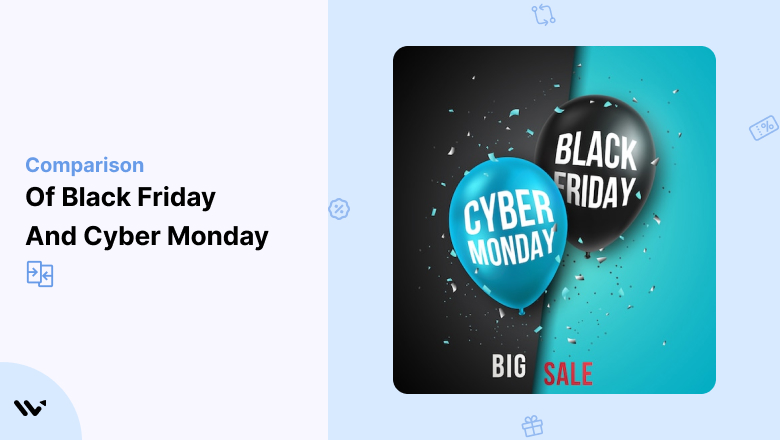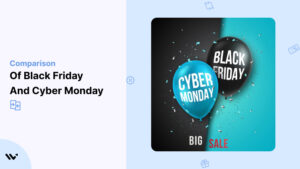Black Friday and Cyber Monday are here, and with them come great deals.
They are all about deep discounts, doorbusters, and finding that perfect gift for a fraction of the price.
Knowing the difference between Black Friday and Cyber Monday as you plan your holiday shopping will help you save more and shop smarter.
In recent years, more and more people are shopping online instead of braving the crowds in stores.
This has made Black Friday and Cyber Monday even more critical, blurred the lines, and created a shopping weekend often called Cyber Week.
Here, we’ll break down the pros and cons of cyber monday vs black friday and give tips to get the most out of the deals.

Black Friday vs Cyber Monday
1. Timing and Focus
Black Friday starts immediately after Thanksgiving Day and is the official start of the holiday shopping season.
Traditionally, it’s focused on in-store shopping and doorbusters that get shoppers into physical stores early in the morning.
Lining up outside stores and the rush to take advantage of limited-time offers have become big parts of Black Friday.
Cyber Monday is on the Monday after Thanksgiving.
It was created to allow online retailers to offer big discounts and ride the wave of online sales.
Cyber Monday is focused on online shopping for those who prefer to shop from their computers or mobile devices.
2. Product Categories and Deals
As for the types of deals, Black Friday deals usually include deep discounts on big-ticket items like electronics, appliances, and power tools.
Great deals are available on the latest TVs, laptops, and home appliances, so it’s a good time to buy big at a lower price.
Cyber Monday deals focus on a wider range of products, including smaller electronics, clothing, accessories, and online-only items.
Cyber Monday offers online discounts across many product categories, making it an excellent time to find deals on items that may not have been discounted on Black Friday.
Start Free Trial
Highlight real-time activities like reviews, sales & sign-ups.
3. Target Market
Black Friday attracts a broader audience, including those who enjoy in-store shopping.
The thrill of the hunt, the excitement of doorbusters, and the tradition of shopping with family and friends get many consumers into physical stores.
Cyber Monday is more for tech-savvy shoppers and those who prefer to shop online.
It’s for those who want to avoid crowds and can easily compare prices and products from their homes.
4. Shopping Experience
The shopping experience is very different between the two.
Black Friday can be crazy and crowded, with long lines, packed stores, and fast-selling items.
The pressure to make quick decisions and the possibility of impulse buys add to the intensity of the day.
Cyber Monday is more relaxed and convenient.
Shoppers can browse deals at their own pace without the physical chaos of in-store crowds.
But with so many online deals, it can be hard to sift through them all.
Black Friday Pros and Cons

➠ Pros
Black Friday is all about discounts on popular items. You can find better deals on big-ticket items that are rarely discounted at other times of the year.
For many, shopping in-store on Black Friday is a tradition. The thrill of getting an item you want adds to the holiday cheer.
You can see and try products before you buy, which is especially helpful for items like clothing or electronics.
➠ Cons
Too many shoppers mean crowded stores and long lines, which can be frustrating and time-consuming.
High-demand items may sell out fast, so you miss out.
Pressure and excitement can make you buy items not on your shopping list and overspend.
Cyber Monday Pros and Cons

➠ Pros
On Cyber Monday, you can shop from anywhere online, so you won’t have to go to the stores.
Many online retailers participate so you can access products across many categories.
You can compare prices across multiple sites to find the best deals.
➠ Cons
High volumes of orders can mean shipping delays, and items may be out of stock by the time you buy.
You can’t see or try products before you buy, which may mean returns or later exchanges.
There are so many deals that it’s hard to find good ones.
Here’s a video you can watch to better understand both days.

Black Friday vs Cyber Monday for SMB
Black Friday and Cyber Monday impact retail not just for big retailers but also for small businesses.
These shopping holidays present opportunities and challenges for small businesses to carve out a niche in a competitive market during the holiday season.
Opportunities for Small Business
➥ By participating in Black Friday deals and Cyber Monday sales, small businesses can tap into the increased consumer spending. They can attract online and in-store shoppers by offering unique products or personalized services.
➥ Online shopping trends allow small businesses to reach a wider audience without expanding physically. An optimized online store can compete globally during Cyber Week.
➥ Small businesses are good at customer service. During these significant shopping events, they can deepen customer relationships through personalized experiences and encourage repeat business beyond the holiday season.
Challenges for Small Businesses
➥ Competing with the deep discounts and doorbusters of more giant retailers can squeeze small business margins. They may not be able to match the aggressive pricing and stay profitable.
➥ Without the big marketing budgets of more prominent companies, small businesses may struggle to reach their audience. Getting visibility during the busy holiday season requires creative and cost-effective marketing.
➥ Managing stock levels to meet the increased demand without overstretching resources is a fine balance. Supply chain disruptions can have a more significant impact on small businesses with less buffer.
➥ Ensuring their website can handle the increased traffic during Cyber Monday is critical. Technical glitches or slow load times can mean lost sales and damage to the brand.

The Environmental Impact
The consumerism frenzy of Black Friday vs Cyber Monday has raised questions about the environmental impact of these shopping holidays.
The increase in production, transportation, and waste generated by the holiday season is a problem that needs to be addressed.
Packaging Waste
➤ Too Much Packaging: Online sales means more packaging waste from individual shipments. Cardboard, plastic, and styrofoam end up in landfills and pollute.
➤ Single-Use Plastics: Many products are packaged with single-use plastics that are not biodegradable and add to the plastic pollution problem.
Carbon Emissions from Transportation
➤ Shipping Emissions: The logistics of delivering millions of packages generates a lot of carbon emissions. Express shipping options increase the environmental impact as delivery routes are less efficient.
➤ Consumer Travel: In-store shopping during Black Friday means more vehicle usage, traffic and emissions as shoppers travel to and from physical stores.
Stats of Both Days
Total Sales
Black Friday and Cyber Monday are now established holiday events, generating billions in sales annually.
According to Wisernotify, which tracks online transactions, Cyber Monday 2021 hit a record $10.7 billion in US online sales.
This is slightly lower than the $10.8 billion in 2020 but still massive.
Black Friday 2023 also performed well with $9.5 billion online sales, high from $9 billion in 2020.
Despite the small year-over-year decline (due to early promotions and a longer holiday season), these numbers show sustained consumer interest and a big economic impact during these events.
Online vs In-Store
The holiday shopping landscape is changing, and online shopping is growing.
In 2021, 77% of Black Friday shoppers shopped online, and online sales are no longer limited to Cyber Monday.
Due to the pandemic, online convenience and health and safety concerns have accelerated this trend.
On the other hand, in-store shopping saw a comeback in 2021 compared to 2020, but foot traffic was still below pre-pandemic levels.
Physical stores introduced curbside pickup and enhanced safety protocols to cater to shoppers who prefer to shop in-store.
The mix of online and in-store shopping shows consumers want flexibility and convenience.
Top Categories
Both Black Friday and Cyber Monday have specific categories that consistently top the sales charts:
➠ Electronics: High-demand items like smartphones, laptops, TVs, and gaming consoles see significant discounts. For example, video game console sales went through the roof, with many retailers offering doorbusters.
➠ Appliances: Black Friday staples include small appliances like coffee makers and big-ticket items like refrigerators.
➠ Fashion and Apparel: Cyber Monday deals often offer big discounts on clothing, shoes, and accessories for online shoppers.
➠ Toys and Games: With the holidays near, toys are hot, and many retailers offer deep discounts to holiday shoppers.
➠ Home Goods and Décor: Items for the home see more interest as consumers prepare for holiday gatherings or looking for gifts.
Consumer Behavior
Consumers are getting more strategic during these shopping holidays:
⦿ There’s a trend to start holiday shopping earlier. In 2021, many retailers started promotions weeks in advance, hence the concept of Cyber Week.
⦿ Smartphones are being used more for shopping. Mobile devices accounted for over 40% of online sales during these events, which highlights the importance of mobile-optimized online stores.
⦿ With economic uncertainty, consumers are more price-conscious, using tools to compare prices and looking for cheaper prices without compromising on quality.
⦿ Consumers are spending more time researching products and reading reviews before buying, especially for big-ticket items.
⦿ A growing segment of consumers is considering the environmental impact of their purchases, favoring brands that demonstrate sustainability and ethical practices.
How to Save Big on Both Days
1. Research and Planning
- Make a Shopping List: List the items you want to buy and prioritize them.
- Set a Budget: Determine how much you’re willing to spend to avoid impulse buying.
- Research Products: Read reviews and specs to ensure the product meets your needs.
Also see: Crush Black Friday with This Complete Checklist
2. Price Matching
- Use Price Comparison Tools: Websites and apps can help you find cheaper prices across different retailers.
- Check Multiple Stores: Don’t rely on one store; check multiple options to find the best deals.
3. Early Bird Deals
- Start Early: Many retailers offer deals before Black Friday, sometimes a week in advance.
- Stay Informed: Follow your favorite brands on social media or sign up for newsletters to get updates on early promotions.
Also see: 9 Black Friday Social Media Post Examples to Boost Sales
4. Email Signups and Loyalty Programs
- Sign up for Emails: Retailers often send their subscribers exclusive deals and discount codes.
- Join Loyalty Programs: Membership gives you access to special offers and early access to sales.
Bottom Line
Whether you like the in-store experience of Black Friday or the comfort of online shopping on Cyber Monday, both offer significant savings and great deals on many products.
Now that you know the differences, plan, stay informed, and shop smart.
The holiday season is not just about the deals but also about enjoying the experience and making wise purchases that bring joy to you and your loved ones.






